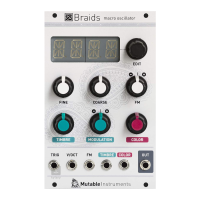DRFT recreates the imperfections of a disastrously designed VCO, by combining power
supply hum, power supply fluctuations due to poor digital section decoupling and noise and
temperature instabilities. The combination of these factors is unique to each module built.
SIGN applies glitches/waveform imperfections to the output signal. The exact behavior of
this option is unique to each module built.
BRIG adjusts the screen brightness.
Calibration
Braids uses digital processing to scale its input control voltages. To calibrate the unit,
disconnect any signal from the FM input, and connect the note CV output of a well-calibrated
keyboard interface or MIDI-CV converter to the V/OCT input. Move the “Coarse” and “Fine”
knobs to 12 o’clock position. Go to CAL. in the options list, and keep the encoder pressed for
1s (this is not an option you want to select by mistake during a performance !). The screen
displays >C2 . Input a CV corresponding to a C2 note (1V). Click on the encoder. The screen
displays >C4 . Input a CV corresponding to a C4 note (3V). Click on the encoder to finish
calibration. Because Braids uses this software calibration procedure, it is compatible with the
1.2V/Oct standard too! Here is a tip: you can very well perform the calibration procedure with
another pair of notes 2 octaves apart, and with the COARSE knob in another position. This
can be used to shift up or down the range of the COARSE knob.
Toys
Following CAL. in the menu is a screen showing a visual representation of the internal ADC
readings for the TIMBRE, COLOR, V/OCT and FM inputs. This page is helpful for visualizing
the polarity and range of incoming CV signals.
The next option shows a scrolling line of text. TIMBRE controls the scrolling; and a
gate/trigger can be used to scroll the text left by one column. To edit the text, keep the
encoder pressed for more than 1s. Rotate the encoder to select the first character. Click to
move to the next character and continue editing. Once the line of text has been composed,
select the last character (all segments lit) to confirm. At any time, you can also hold the
encoder to leave the edit mode.

